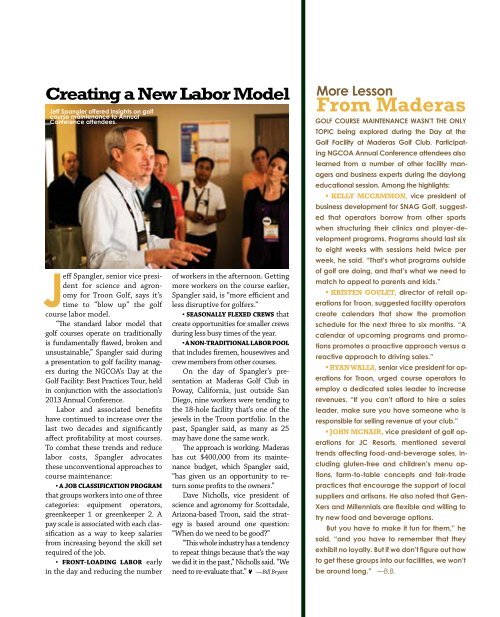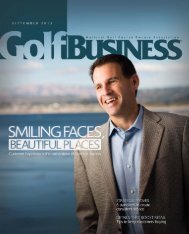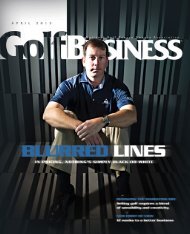Community - GolfBusiness
Community - GolfBusiness
Community - GolfBusiness
You also want an ePaper? Increase the reach of your titles
YUMPU automatically turns print PDFs into web optimized ePapers that Google loves.
Creating a New Labor Model<br />
Jeff Spangler offered insights on golf<br />
course maintenance to Annual<br />
Conference attendees.<br />
Jeff Spangler, senior vice president<br />
for science and agronomy<br />
for Troon Golf, says it’s<br />
time to “blow up” the golf<br />
course labor model.<br />
“The standard labor model that<br />
golf courses operate on traditionally<br />
is fundamentally flawed, broken and<br />
unsustainable,” Spangler said during<br />
a presentation to golf facility managers<br />
during the NGCOA’s Day at the<br />
Golf Facility: Best Practices Tour, held<br />
in conjunction with the association’s<br />
2013 Annual Conference.<br />
Labor and associated benefits<br />
have continued to increase over the<br />
last two decades and significantly<br />
affect profitability at most courses.<br />
To combat these trends and reduce<br />
labor costs, Spangler advocates<br />
these unconventional approaches to<br />
course maintenance:<br />
A JOB CLASSIFICATION PROGRAM<br />
that groups workers into one of three<br />
categories: equipment operators,<br />
greenkeeper 1 or greenkeeper 2. A<br />
pay scale is associated with each classification<br />
as a way to keep salaries<br />
from increasing beyond the skill set<br />
required of the job.<br />
FRONT-LOADING LABOR early<br />
in the day and reducing the number<br />
of workers in the afternoon. Getting<br />
more workers on the course earlier,<br />
Spangler said, is “more efficient and<br />
less disruptive for golfers.”<br />
SEASONALLY FLEXED CREWS that<br />
create opportunities for smaller crews<br />
during less busy times of the year.<br />
A NON-TRADITIONAL LABOR POOL<br />
that includes firemen, housewives and<br />
crew members from other courses.<br />
On the day of Spangler’s presentation<br />
at Maderas Golf Club in<br />
Poway, California, just outside San<br />
Diego, nine workers were tending to<br />
the 18-hole facility that’s one of the<br />
jewels in the Troon portfolio. In the<br />
past, Spangler said, as many as 25<br />
may have done the same work.<br />
The approach is working. Maderas<br />
has cut $400,000 from its maintenance<br />
budget, which Spangler said,<br />
“has given us an opportunity to return<br />
some profits to the owners.”<br />
Dave Nicholls, vice president of<br />
science and agronomy for Scottsdale,<br />
Arizona-based Troon, said the strategy<br />
is based around one question:<br />
“When do we need to be good”<br />
“This whole industry has a tendency<br />
to repeat things because that’s the way<br />
we did it in the past,” Nicholls said. “We<br />
need to re-evaluate that.” —Bill Bryant<br />
More Lesson<br />
From Maderas<br />
GOLF COURSE MAINTENANCE WASN’T THE ONLY<br />
TOPIC being explored during the Day at the<br />
Golf Facility at Maderas Golf Club. Participating<br />
NGCOA Annual Conference attendees also<br />
learned from a number of other facility managers<br />
and business experts during the daylong<br />
educational session. Among the highlights:<br />
KELLY MCCAMMON, vice president of<br />
business development for SNAG Golf, suggested<br />
that operators borrow from other sports<br />
when structuring their clinics and player-development<br />
programs. Programs should last six<br />
to eight weeks with sessions held twice per<br />
week, he said. “That’s what programs outside<br />
of golf are doing, and that’s what we need to<br />
match to appeal to parents and kids.”<br />
KRISTEN GOULET, director of retail operations<br />
for Troon, suggested facility operators<br />
create calendars that show the promotion<br />
schedule for the next three to six months. “A<br />
calendar of upcoming programs and promotions<br />
promotes a proactive approach versus a<br />
reactive approach to driving sales.”<br />
RYAN WALLS, senior vice president for operations<br />
for Troon, urged course operators to<br />
employ a dedicated sales leader to increase<br />
revenues. “If you can’t afford to hire a sales<br />
leader, make sure you have someone who is<br />
responsible for selling revenue at your club.”<br />
JOHN MCNAIR, vice president of golf operations<br />
for JC Resorts, mentioned several<br />
trends affecting food-and-beverage sales, including<br />
gluten-free and children’s menu options,<br />
farm-to-table concepts and fair-trade<br />
practices that encourage the support of local<br />
suppliers and artisans. He also noted that Gen-<br />
Xers and Millennials are flexible and willing to<br />
try new food and beverage options.<br />
But you have to make it fun for them,” he<br />
said, “and you have to remember that they<br />
exhibit no loyalty. But if we don’t figure out how<br />
to get these groups into our facilities, we won’t<br />
be around long.” —B.B.




